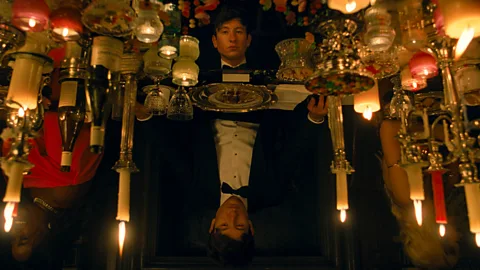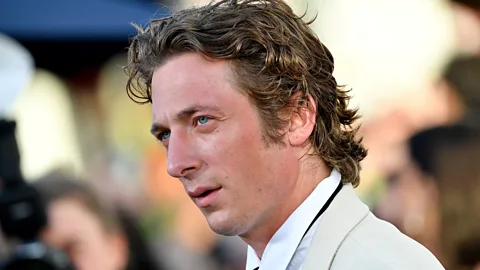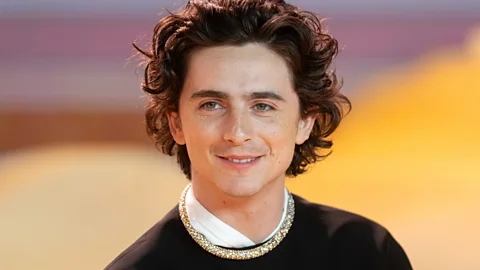[ad_1]
 Amazon MGM Studios
Amazon MGM StudiosFrom Josh O’Connor and Mike Faist to Jeremy Allen White and Glen Powell, the controversial ‘hot rodent’ trend has much to say about male privilege and beauty standards in Hollywood.
In May, as The Hollywood Reporter published its controversial “new A-List” of stars for 2024, an internet phrase used to describe the attractiveness of a singular group of male celebrities became a contested topic in itself. The term was “Hot Rodent Man”.
Memes from the 2007 Pixar animation Ratatouille were brought forth by online commentators to suggest that there was a group of new male celebrities considered Hollywood’s latest sex symbols despite (or because of?) having “rodent-like” features. They included Josh O’Connor and Mike Faist, the stars of tennis threesome drama Challengers, Saltburn‘s Barry Keoghan, Jeremy Allen White (The Bear) and Glen Powell (Hit Man). Further examples of the “hot rodent” aesthetic supposedly included Tom Holland, Adam Driver, The 1975 singer Matty Healy and Timothée Chalamet. Angular features, a larger nose and often unkempt hair were the shared physical characteristics of the trend. In June, The New York Times (among others) asked Who is a ‘Rodent Man’? The conversation had peaked.
“Hot rodent” joins the constantly regenerating roster of male celebrity labels that includes the “Golden Retriever boyfriend”, said to describe a man who is particularly affectionate and excitable, (see Taylor Swift‘s partner Travis Kelce). The “short king” title has been around for longer, epitomised by Daniel Radcliffe, The Weekend, Jeremy Allen White (again), Tom Holland and Cillian Murphy, whose looks and charisma are celebrated alongside their relatively small stature. “Short kings” are said to have confidence in themselves, and be happy with their height – an implicit acknowledgement that Western society has considered smaller men to be somewhat less masculine than their taller counterparts.
Aside from their innately giddy, internet-trend silliness, there has, inevitably, been a backlash against such labels’ perceived objectification. These labels are created by the same generation that uses the hashtag #prettyprivilege, an acknowledgement that good looks are perceived as a factor to getting ahead in society. The “hot rodent man” has been derided by some as a particularly unflattering moniker for its recipients. Whether it’s offensive or not, it’s clear that when it comes to deciding what’s sexy, it’s the internet rather than Hollywood that’s driving the conversation.
 Pixar
PixarStudio executives, according to anthropologist Dr Roberta Katz from Stanford’s Center for Advanced Study in the Behavioural Sciences, “were once the people making the movies who decided who would be attractive enough to put in a film. Celebrity associated with those movies became a way of influencing large numbers of people, who would take away that notion of attractiveness”.
That there’s a Hollywood standard of conventional male attractiveness is felt by the actors themselves. Discussing his transition to sex symbol through his role as a murderous sociopath in Emerald Fennell’s Saltburn, Barry Keoghan told GQ Magazine that “my prettiness didn’t get me this far”. He added: “it’s nice not just being looked at as the weird-looking guy, the unique freaky little freak man-child.”
A continuation of male privilege?
However, it’s arguably small fry in comparison to the physical objectification female stars have endured in the media. The French phrase jolie-laide (“pretty-ugly”) has been used for more then a century, typically aimed (although not exclusively) at women considered alluring despite their irregular features. From the late 1990s onwards, celebrity media sites have focused on famous women’s bodies, listing the most attractive female celebrities and scrutinising their physical shape, particularly after giving birth. The bodies of men increasingly appear on these sites, but so far, there are no comparable internet lists of women grouped according to their physical attributes in line with “hot rodents” or “short kings” – a tacit acknowledgement perhaps that the message about objectifying women (openly at least) is sinking in.
 Amazon MGM Studios
Amazon MGM StudiosFemale actors have also historically suffered disproportionately more from arbitrary beauty standards than men in Hollywood, especially in the context of being allowed to play a romantic lead, according to Kristy Guevara-Flanagan, a documentary filmmaker and professor at UCLA. “I think the entire history of cinema has been based on a narrow perspective of who can be attractive, who can be sexy, who can be seen as a romantic partner, particularly when it comes to women,” she tells the BBC.
“There was a certain type of strong female actor such as a Bette Davis historically who got some notoriety, but more as a character actor or an archetype, and less as just the romantic lead. Romantic leads for women were usually blonder and smaller-featured and generally white. And I’d say it’s changed minutely. Women still have to be thin, still have to be young. The higher the blockbuster, the narrower the range gets.”
So is the “hot rodent” or “short king” simply a continuation of male privilege in Hollywood, where men have always had more scope than their female counterparts to be considered attractive? Male studio bosses may have chosen Cary Grant or James Stewart as romantic leads, but that didn’t stop less conventionally handsome Humphrey Bogart or Bing Crosby also breaking through. In the 1970s, both blonde, blue-eyed Robert Redford, and short-in-stature Dustin Hoffman were both judged to be, in the language of the time, “pin-ups”.
“Men have had it easier as ideals of masculinity in Hollywood have been much more freewheeling,” says Professor Viren Swami, a social psychologist at Anglia Ruskin University in the UK and an expert on attraction and body image. “You could be successful at work, or endurance sports, or in terms of finance. None of them had anything to do with appearance. If anything, focusing on your appearance was socialised to mean that you were feminine and for a long period, men did not have to focus on their appearance in the same way as women.”
The physical objectification of men, Swami says, really began in the 1980s and 1990s – the era of Tom Cruise in Top Gun, Arnold Schwarzenegger in The Terminator and Sylvester Stallone in Rambo. “For the first time, men were socialised to think that if you want to be masculine, you also have to be muscular whilst being lean at the same time,” he says. “I often use the James Bond example in my teaching. No offence to Sean Connery… he was toned but not muscular in the kind of way that we would expect today. Daniel Craig on the other hand spent a lot of time in the gym to depict James Bond in its most contemporary fashion.”
 Getty Images
Getty ImagesThat emphasis on lean muscularity, combined with advertising of the time mostly offering a Caucasian ideal, might explain why names like Brad Pitt, Chris Hemsworth, Hugh Jackman or Ryan Gosling have been held up as being the pinnacles of handsomeness during the last 25 years. It might also help answer, along with the historical prejudices of mass media, why so few black and Asian male sex symbols have existed in Hollywood, a trend that continues, including with these contemporary internet terms, and on The Hollywood Reporter’s 2024 A-List report, where Zendaya was the only actor of colour included.
“Up until the 1960s, for example, the number of people of colour who appeared in Hollywood films was minuscule and didn’t reflect the wider population,” Swami says. “In advertising up until the 1980s, the representation of people of colour was nothing, if you consider the global population worldwide. And there is some evidence to suggest that even when local forms of media, for example in Asia, depicted what was “ideal”, they often portrayed what was ideal to a Western consumer, as they were opening their economies to the West.”
Being the ‘good guy’
If the categorising of these new male sex symbols of the 2020s doesn’t seem to yet have caught up with the decade’s emphasis on diversity, what is different is the emphasis on the “niceness” of their personalities. The rise of actor Timothée Chalamet as a Gen Z-icon shows how the generation’s values are influencing their choices of what it being found attractive. Twenty-eight-year-old Chalamet may have a classically handsome face (also, apparently, a “rodent” one), but he’s well-known for his commitment to a “good guy” image – wearing sustainable and ethical clothing on the red carpet and designing a garment where all the proceeds went to support a charity preserving women’s rights in Afghanistan. Other male actors including Josh O’Connor have reputations for being congenial and quirky in interviews – videos of which can be viewed online and which trend in seconds.
“There used to be that very narrowly defined archetype of male attractiveness in Hollywood, the popular, white, high-school athlete stereotype, but now we’re seeing the focus on ‘good-looking’ men who are also associated with sensitivity, emotional vulnerability, good morals, and an authentic personality,” Gen Z author, researcher and podcaster Meghan M Grace tells the BBC.
“In our studies on what matters in friendships and relationships, Gen Z ranks shared values far ahead of physical looks, and also shared identities, backgrounds, or even shared hobbies. Of course, good looks in a celebrity can, and will, still be prized by the public regardless of tales of bad behaviour, but Gen Z fans in particular might then reassess how attractive they found that person.
“I think gone are the days when a ‘leading man’ can be attractive and publicly popular for good looks but be a jerk behind the scenes,” Grace says.
 Getty Images
Getty ImagesDr Roberta Katz, who co-authored a book that studied Gen Z, believes authenticity is vital to most young people, hence the emphasis on character attributes of a so-called “golden retriever” or a “short king”. “Authenticity is a value in part related to the fact that these young people have grown up seeing a decline in trust in the world,” she tells the BBC. “In all our institutions, seeing fake news, seeing a lot of hype, seeing a ton of advertising, authenticity really means, ‘Can I trust you? Can I trust that what you say is what you will do? If it turns out not, then you’ve lost all my trust.’ Their other values include diversity, and preference against hierarchical structures.”
It’s clear that the transfer of taste-making power from studios to social media will have deep consequences for Hollywood unless the industry takes notice, according to Professor Stacy Smith, founder of the Annenberg Inclusion Initiative. “Gen Z have an algorithm on TikTok and Instagram and other sites that is feeding them something uniquely tailored to who they are and what they care about. They’re constantly being given different content, but consistent with what is important to them,” she tells the BBC.
“So then when you translate that to onscreen, that means they want to see the real world in storytelling. Not [what] a cookie-cutter executive in his 50s that’s a white male [thinks] is attractive. Their norms are not singularly focused on physicality. They loved Saltburn, they loved Challengers. But to get them to buy a ticket to the movies based on the physical proclivities of the executive suite of the legacy studios? There’s a complete disconnect [there] because their tastes are different from those executives.”
And there’s a direct correlation between what Gen Z has liked on screen and who they find attractive in the real world, even if some of the so-called “hot rodents” or “retrievers” might consider it a back-handed compliment. These trends, however, are still only one corner of the online world. Many “ordinary” men who aren’t celebrities still feel under pressure to attain the contemporary ideal, lean and muscualar body shape that they see on social media.
“Male influencers portraying the physique of muscularity as being easily achievable and achievable through natural means is a huge industry,” Swami says. “It’s completely changed the way men are relating to themselves and how men are relating to their own ability to function as masculine individuals. “Nor, he adds, has Hollywood totally lost its sway yet in subtly communicating what’s desirable to an audience.
“Remember who’s still the leading man in terms of box office revenue? Dwayne Johnson. ‘The Rock’ hasn’t gone away.”
[ad_2]
Source link


